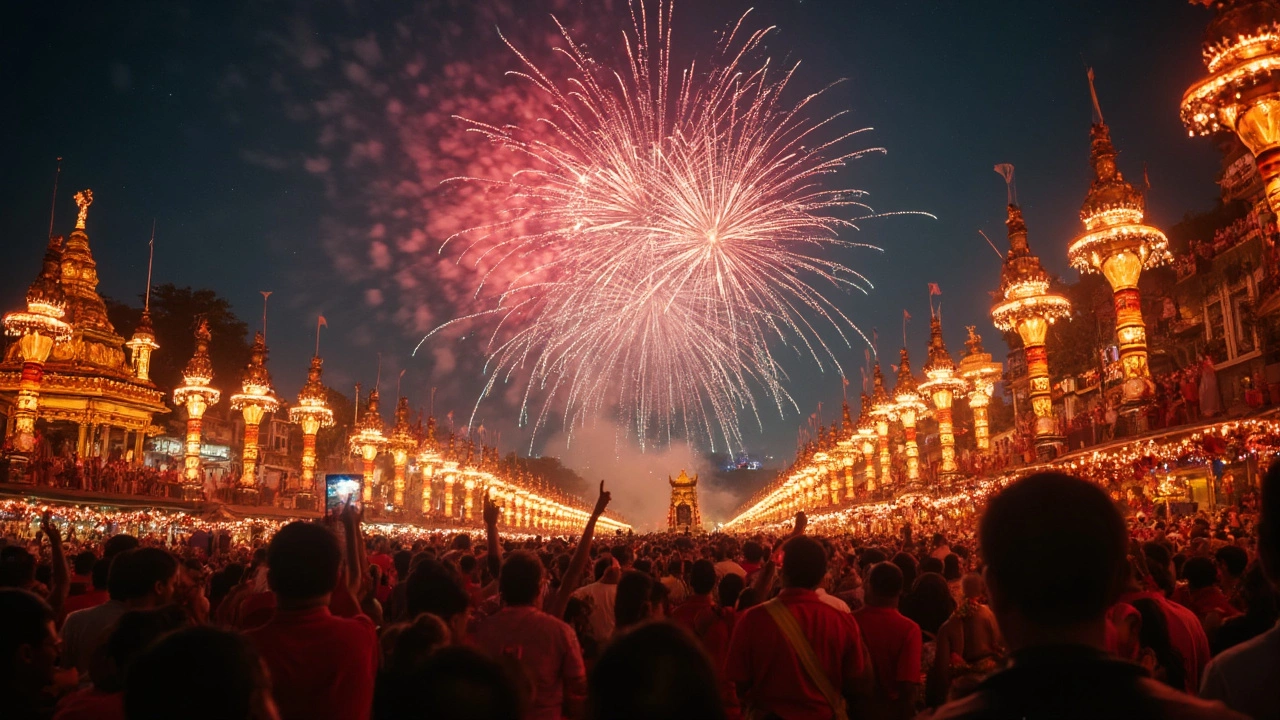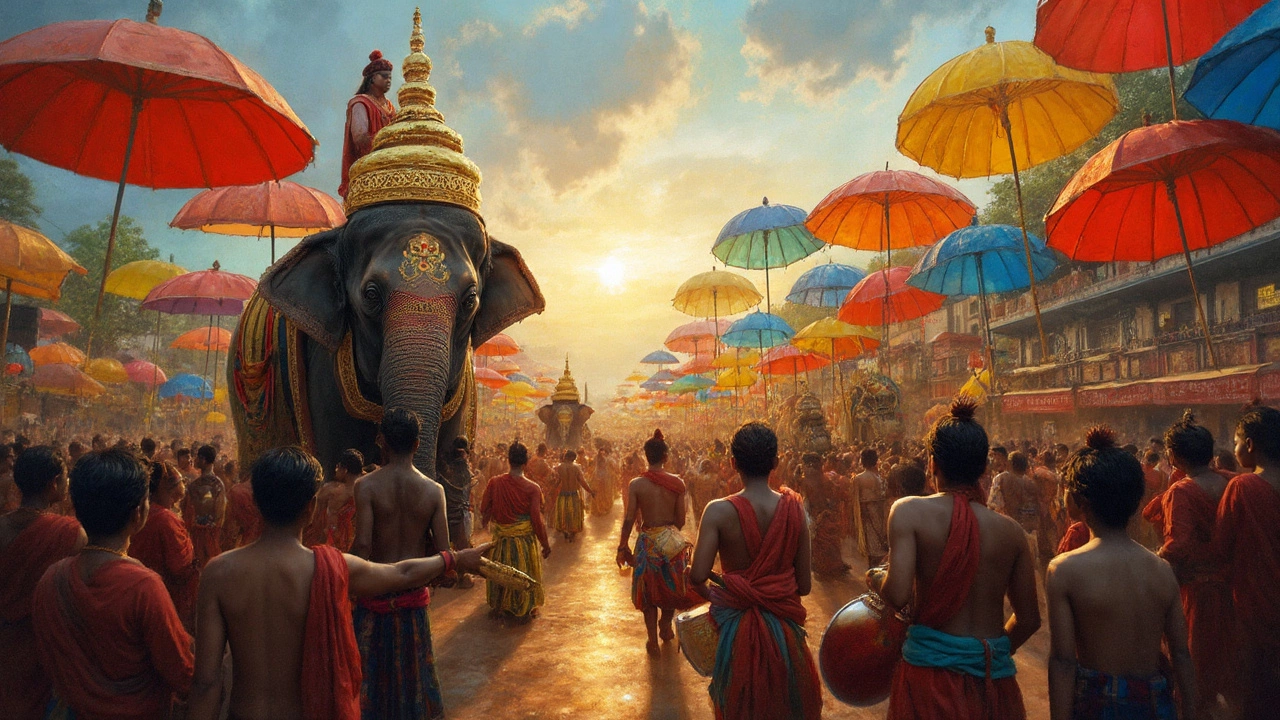India's rich tapestry of traditions offers one unforgettable experience after another, and nothing exemplifies this more than its temple festivals. Amongst these, the Thrissur Pooram stands out not just for its color and joy but for being the oldest, offering a glimpse into ancient times with its roots going back centuries.
This iconic festival is hosted in Kerala, a southern state known for its lush landscapes and traditions. If you're planning a temple tour, the Thrissur Pooram should be on your itinerary. Not only because it's a historical marvel, but because the spectacle—a fusion of music, culture, and devotion—is unlike anything you've ever experienced.
What makes Thrissur Pooram so special? For starters, it's the electrifying percussion ensembles, the grand elephant parades, and the magnificent fireworks that light up the skies. It's the community spirit and the sense of togetherness that binds thousands of people regardless of their backgrounds. And it’s celebrated at the Vadakkunnathan Temple, dedicated to Lord Shiva, right in the heart of Thrissur town.
History and Origins
The story of Thrissur Pooram dates back over two centuries, to 1798, during the reign of Shakthan Thampuran, the then Maharaja of Cochin. It all began when he organized a grand festival that would rival others by bringing people together from different temples to celebrate in unison. Prior to this, the temple festivals were smaller and restricted to local participation. Thampuran wanted something bigger and more inclusive—and he surely achieved it.
One of the key aspects that makes the Thrissur Pooram stand out is its inclusivity. The Maharaja gathered ten temples situated around Thrissur to participate in this grand celebration. Each temple was charged with preparing its own troupe of elephants and percussionists, transforming the festival into a vibrant orchestra of sounds and colors.
Year after year, Thrissur Pooram continued to grow not only in size but also in cultural significance. The event became a melting pot for showcasing traditions, arts, and the best of what local temples had to offer. The Thrissur Pooram isn't just about religious rituals; it became a cultural festival that holds historical importance to this day.
The festival typically occurs during the Malayalam month of Medam (April-May), and since it's set according to the lunar calendar, the exact dates shift each year. The main event is held at the Vadakkunnathan Temple, one of the oldest Lord Shiva temples in Kerala. This central location, literally the heart of Thrissur town, makes it accessible and a vital part of the festival's charm.
Today, Thrissur Pooram is a grand spectacle attracting visitors and tourists from around the world. It remains a cornerstone of temple celebrations in Kerala, celebrated not just for its historic significance but also for the sheer vibrancy and energy it injects into the region.
Unique Traditions
The Thrissur Pooram is not just any temple festival; it's a vibrant explosion of colors, sounds, and emotions. At its heart, lies a series of unique traditions that set it apart from other festivals in India. Here's a glimpse into what makes this ancient celebration special.
Parasol Exchange
One of the most iconic features of the Thrissur Pooram is the ritualistic parasol exchange known as "Kudamattam." This spectacular event is a visual delight where elephants are adorned with ornate parasols and the ensembles engage in a friendly competition, swiftly swapping their colorful parasols in a coordinated display that draws gasps of awe from the audience.
Elephant Procession
The grand elephant procession is a defining element of the festival. Featuring scores of elephants decked out in elaborate regalia, this parade moves through the town's streets, accompanied by the rhythmic beats of traditional percussion instruments. Each temple participating in the Pooram takes pride in showcasing its well-groomed elephants, adding to the festival's grandeur and appeal.
Traditional Music Ensembles
At any Thrissur Pooram, you can expect to be enveloped in the intense and captivating rhythms of traditional music. Chenda Melam, a type of drum ensemble, leads a powerful orchestra made up of several percussion instruments, filling the air with a mystical symphony that's both soul-stirring and energizing.
Pyrotechnic Show
The fireworks display at Thrissur Pooram is legendary, illuminating the night sky with a dazzling array of colors. It's a breathtaking experience where tradition meets skill, as expert pyrotechnicians choreograph a show that leaves spectators spellbound.
These unique traditions are what define Thrissur Pooram and make it a must-see for anyone on a temple tour in India. Whether it's the resplendent elephant parades or the fierce musical competitions, this festival is a treasure trove of cultural heritage waiting to be discovered.

When to Visit
Timing your visit to the Thrissur Pooram can make all the difference in soaking up the festival's vibrant energy. Mark your calendars because this grand event takes place annually in the Malayalam month of Medam, which usually falls around April or May. The exact day of the festival shifts each year based on the Malayalam calendar, aligning with the Pooram star.
This is not just any festival; imagine a 36-hour cultural extravaganza that captivates everyone present. Arriving a few days early helps you see the preparations, which are an experience in themselves as the hustle and bustle of the town ramps up in anticipation. The weather in Kerala during this time is generally warm and humid, so dress comfortably.
To get the best experience, try organizing your trip to include the day before and after the festival. This way, you'll catch the exciting pre-festival events as well as the relaxed vibe that follows. Accommodations can fill up quickly, so early booking is a smart move.
For anyone wanting to see the oldest temple festival India has to offer in full glory, being there in April or May is your window of opportunity.
Tips for Visitors
Visiting the Thrissur Pooram can be an experience of a lifetime, but a little preparation can go a long way to make it even more enjoyable. Whether you're a first-timer or a seasoned traveler, these tips should help you make the most of this grand temple festival in India.
Plan Your Timing
The festival usually occurs in April or May, as it follows the Malayalam calendar. Try to reach Thrissur a few days before the festival to soak in the buildup and catch any pre-festival events. This will also give you time to settle in and explore the city.
Accommodation
Accommodations fill up fast during this time, so it's best to book your place as early as possible. Consider staying near the city center for easy access to festival hotspots. If luxury isn't your priority, there are budget-friendly options like homestays that offer a great way to experience local life.
Stay Safe
- Since the event attracts large crowds, keep your valuables secure.
- Wear comfortable clothing and shoes, as you'll likely spend a lot of time on your feet.
- Stay hydrated and take breaks if you're overwhelmed by the heat or crowds.
Cultural Etiquette
Engage respectfully with local traditions and practices. While photography is mostly welcomed, always ask for permission if you're focusing on individuals. Remember to remove your shoes when entering temples and dress modestly to show respect.
Transportation Tips
It's wise to rely on public transport or rideshare services to navigate through Thrissur during the festival, as roads get busy. Additionally, walking is a great way to experience the local sights and sounds.
Sample the Local Cuisine
No visit is complete without indulging in Kerala's culinary delights. Don’t miss the local street food alongside trying out some traditional eateries. Go for a traditional Kerala Sadya, a feast served on a banana leaf, to get a real taste of the region.
